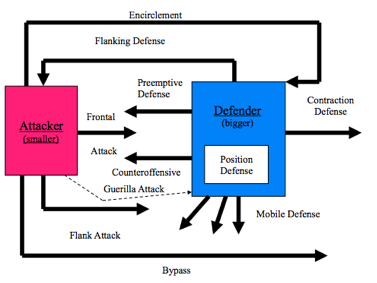I hate revising for exams. This year, I thought I should make my revisions more fun. To revise for my marketing course, I will go through the theories I’m learning (which sometimes seem irrelevant in today’s world) and explain their strengths and why (or if) I disagree with them. Join me for the ride, the first one concerns marketing warfare strategies.

Here is a summary of the warfare strategies.

Let’s start with the attack strategies. A firm (the market challenger) would attack to gain market share and to eventually become the market leader by attacking other firms of the same size or smaller firms.
- Frontal attack: attacking the “opponent” by matching product for product, price for price, advertising for advertising, etc. In the UK, I can think of Tesco and Asda, with Tesco’s “price match”.
- Flanking attack: filling gaps in the market not being served by the leader; for example, a segment of customers not being served or a region of the world where the leader is not doing really well.
- Guerrilla attack: making small, intermittent attacks, for instance by doing price cuts or promotional bursts.
- Bypass attack: trying to diversify into unrelated products to compete with the leader.
- Encirclement: launching a grand offensive against the leader. This is a costly option.
Now, if we look at the defense strategies:
- Position defense: this is a static defense, or marketing myopia.
- Mobile defense: the leader will get involved in R&D, focusing on the customers’ needs rather than the product itself.
- Flanking defense: establishing a defense against some probable but uncertain eventuality.
- Pre-emptive defense: isn’t “prevention better than cure”? Here, the leader will launch an attack against the competitor first.
After going through the marketing warfare literature and learning the different concepts, I came to the conclusion that the theory is deeply flawed.
I think the use of the warfare metaphor is absolutely the wrong one. The theory is from the 80s and it is evident that the Cold War must have influenced it. The theory may have some relevance today (after all, I could recognize the Tesco/Asda strategy behind it). Some expressions such “price wars” or “market invasion” are still being used today. When you look at other strategies, such as the SWOT model, the warfare metaphor is also implied: “threats”, “strengths”, “opportunities”. However, I don’t think marketing is all about “us” versus “them”. It is not a zero-sum game as the marketing warfare literature seems to think.
More appropriate (and positive!) metaphors should be used to talk about marketing strategy: the game metaphor, which is about team work, or the organism metaphor where lifecycle, growth and adaptation help us understand the evolution of products and markets…or even the marriage metaphor where commitment and trust are necessary to form strategic alliances and having a successful marketing strategy.
Moreover, the metaphor excludes the possibility of cooperation between firms. What about partnerships? Partnerships do not even have to be between firms of the same industry. The Nike + iPod product bundle is a great illustration of partnerships between two firms, Apple and Nike, belonging to two different industries (entertainment/technology vs sports). Even in firms of the same industry, firms often cooperate for R&D, for example in the petroleum industry.
Finally, I think the use of such metaphors can have unintended consequences. If firms (or marketers) start using such “negative” metaphors, it can promote unethical practices and promote “cut-throat” competition. Companies should instead find a way to develop their internal strengths, fix their internal weaknesses and listen to customers’ needs to become truly customer-oriented.
What do you think of the warfare metaphor? Do you think it’s still useful? Leave a comment below!
nice but you do not speak about other strategy